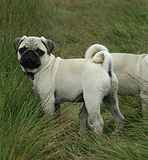
The Pug is a sturdy, compact, squarely proportioned breed endowed with a soft,
smooth coat, furry ears, and a dark muzzle. It has a somewhat undershot bite,
a tightly curled tail, a unique rolling pace, and dark, emotive eyes. Traders
of Holland found it in (and brought it back from) China before the 16th century.
The breed’s popularity ensued, following the victory of William I, Prince
of Orange, himself a Pug owner. Later, it also became a popular royal breed
in the Victorian era of England.
Life Expectancy:
12-15 years
Energy Level:
Medium-Low
Living Conditions:
Indoors. Sensitive to extreme temperatures.
Barking:
Average
Exercise Needs:
Short walks and indoor play.
Breed Group:
Toy, Mastiff
Size:
Small
Height:
10 - 14 inches
Weight:
13 - 20 pounds
Standard Hair Colors:
Apricot, black, silver, fawn and tan.
National breed club:
Pug Dog Club of America
In the past, the Pug rubbed elbows with nobility as a lap dog, and served as carrier of messages to Napoleon from his wife, Josephine, while she was in prison in 1790. It remains, to this day, a popular companion and proud show dog. It can also perform tricks and do well as a watchdog.
The highly intelligent Pug gets easily uninterested with routine exercise and training. It carries a laid-back attitude, though requires a good amount of attention from its handler, otherwise it gets jealous. It is a good watchdog and loyal companion. Pugs tend to be quite clean and affectionate, though have the habits of wheezing and snoring. Nevertheless, they are quite lovable and well behaved around children and strangers, other dogs and pets.
Regular exercise and occasional vigorous games will keep this breed mentally and physically healthy. It will also enjoy short walks in temperate weather. However, its wheezing should be taken as a signal to discontinue exercise and give it a break.
Apartment living is suitable for the Pug, as it is easily affected by the humidity and heat, nor is it well suited for the cold weather, of the outdoors. It does well without a yard, as it should be kept under a comfortable atmosphere. It is fairly sedentary when left indoors.
The Pug’s facial wrinkles should be cleaned and dried down on a daily basis. Occasional brushing of the coat will do to remove dead hair. Also, the Pug needs to be thoroughly dried after a bath to avoid chills.
The Pug is prone to colds and allergies, as it is easily affected by extreme weather conditions. Breathing problems are also common, due to its short muzzle. It also has sensitive eyes and skin and is prone to hip dysplasia. Also, the owner needs to be careful in feeding it, as a Pug tends to become obese with uncontrolled feeding.
The medium version of the Pug is the Bulldog, which is just as fun loving
and friendly as the former, though considerably less active. It is also well
mannered around others.

Copyright © 2005-2016 Pet Information All Rights Reserved
Contact us: www162date@outlook.com